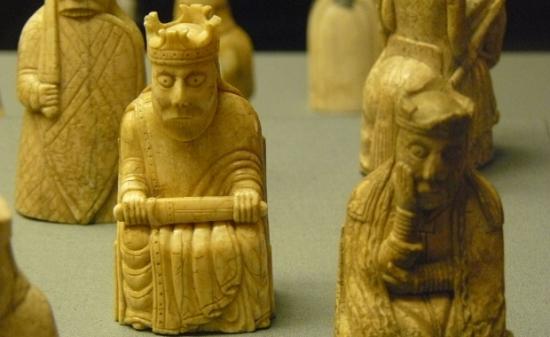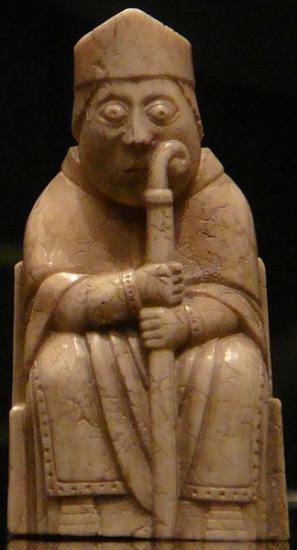Source -http://icelandmag.visir.is/article/2200-year-old-walrus-bones-suggest-most-famous-medieval-chess-set-might-be-icelandic-origin
 THE LEWIS CHESSMEN - A ferocius berserker (rook), a stern king and a contemplative queen. Photo/Wikimedia, published under a Creative Commons license.
THE LEWIS CHESSMEN - A ferocius berserker (rook), a stern king and a contemplative queen. Photo/Wikimedia, published under a Creative Commons license.
Carbon dating of walrus bones found in Snæfellsnes peninsula indicates that the bones are at least 2000 years old. A large number of walrus skulls and walrus tusks have been found around Garðafjara beach on the south coast Snæfellsnes. The first skull was discovered 1884. All in all the bones of 50 walruses have been found, most in the past 50 years. Biologists argue this indicates Snæfellsnes was the home of a sizable walrus colony prior to the settlement of Iceland.
Large pre-settlement colonies of walruses in Iceland
A previous theory, explaining the concentration of bone discoveries, speculated they came from the wreck of a ship which had been carrying walrus bones to Europe. However, the existence of a large walrus colony in Iceland would have meant the accumulation of walrus skeletons and skulls which would have been discovered by the Viking age settlers of Iceland.
Hilmar J. Malmquist, the chief of the Icelandic Natural History Museum points out in an interview with the local newspaper Fréttablaðið that such graveyards of walrus bones could also explain references to walruses in Icelandic place names, shedding light on the possible use of walrus ivory by the early settlers of Iceland who could have had access to domestic ivory found in such bone yards.
Supports a controversial theory o the origin of the most famous medieval chess set
Walrus ivory was traded by Viking merchants who also used it to carve works of art. One of the most famous examples of Norse ivory are the Lewis chessmen, who are on display at the British Museum. The Lewis chessmen were discovered on the Isle of Lewis in the Outer Hebrides north of Scotland. They are one of only a handful of full medieval chess sets ever found, carved out of walrus ivory and whale teeth. The Lewis chessmen are both one of the most important possessions of the British Museum, and certainly one of the most popular. The rooks are especially popular, as they are in the form of berserkers biting their shields.
 A BISHOP - Nowhere were bishops referred to as bishops outside of Iceland during the time when the Lweis chessmen were carved. Wikimedia creative commons
A BISHOP - Nowhere were bishops referred to as bishops outside of Iceland during the time when the Lweis chessmen were carved. Wikimedia creative commons
The origin of the chessmen has been hotly disputed, with one theory pointing to Icelandic origin. The argument for the Icelandic origin of the Lewis chessmen is that only in Icelandic were the bishop pieces called that, bishops. Bishop pieces were not called bishops in English until the 16th century, and in all other Scandinavian and Germanic languages bishops were called “runners” or “messengers”. The bishops in the Lewis set, however, are dressed as bishops in ceremonial garb with a staff, indicating that the person who carved the men would have been Icelandic.
If the settlers of Iceland found large stock of walrus ivory in Iceland the carving of artwork from ivory would have had greater opportunity to develop, which supports the theory the chessmen were actually carved in Iceland.